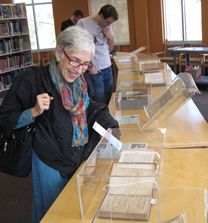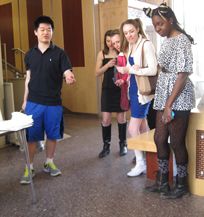Isaac Newton’s tree now grows on campus, but don’t expect apples soon
It doesn’t look like much—a slender five-foot wand topped by the barest wisp of dried leaf—but it is in fact a descendant of one of the world’s most famous trees—the apple tree that inspired Isaac Newton’s concept of universal gravitation.
Some 200 people gathered outside of Small Hall for a ceremonial planting of William & Mary’s Newton tree on Feb. 22. Eventually three Newton trees will grow outside the physics building, planted near a bench from which one can contemplate universal gravitation.
The ceremony marked the conclusion of a three-year odyssey to bring a Newton tree to campus. The tree is William & Mary’s second tangible link to the great scientist; Newton Day festivities included a display of Swem Library Special Collections Research Center’s copy of Newton’s Principia. Jackson Olsen ’17 gave a presentation on the ongoing effort to trace the mysterious annotator of William & Mary’s copy of the Principia. The Society of Physics Students staged Newtonfest, offering liquid nitrogen ice cream, fun science exhibits and lab tours inside and outside of Small Hall.
{{youtube:medium:left|7st-01Un9HE, Newtonfest}}
Special guests in the Newton Day celebration included Mordecai Feingold, a Newton historian at CalTech who gave a talk on Newton’s lesser-known efforts to reconcile Christian scripture and pagan myth and Dava Sobel, author of the books Longitude and Galileo’s Daughter, who gave an intimate talk on the craft of science writing to undergraduates and introduced a staged reading of her play directed by Liz Wiley, associate professor of theatre.
 Remarks at the planting ceremony teased elements of the history of Newton’s apple from the myth, and traced the lineage and development of apples in general as well documenting the lengthy pedigree of William & Mary’s new Newton tree.
Remarks at the planting ceremony teased elements of the history of Newton’s apple from the myth, and traced the lineage and development of apples in general as well documenting the lengthy pedigree of William & Mary’s new Newton tree.
“One day when 22- or 23-year-old Isaac Newton happened to be watching a tree, he really changed everything,” Joshua Erlich told the crowd. “And that’s what we’re here to celebrate today.
The Small Hall tree came from MIT, alma mater of Erlich, associate professor of physics at William & Mary. He had read in an MIT alumni publication about the anniversary of its own Newton tree and thought it would be fitting to get a cutting of MIT’s tree, as William & Mary alumnus and faculty member William Barton Rogers was instrumental in the founding of MIT.
Erlich’s idea was taken up by Marc Sher, professor of physics, and eventually a letter was sent to William & Mary President Taylor Reveley, who said in his remarks at the planting ceremony that the letter requesting him to take the lead in securing a cutting from MIT’s Newton tree was “one of the most exotic requests I’ve ever gotten—and one of the most intriguing.”
Reveley, appropriately resplendent in an apple-green bow tie, told the audience that he initiated the request to MIT—and in his dealings with the great Massachusetts university, he wasn’t above playing the William Barton Rogers card.
“I kept reminding them that MIT owes its very life, its creation, its existence, to William & Mary, because it was a William & Mary alumnus and professor who actually did create MIT,” Reveley said. “They were grateful.”
Sher, who took the lead in organizing the event, also served as master of ceremonies at the planting ceremony.
“I have to mention that my world view was completely changed a couple of months ago when I learned that the apple that Newton saw fall was green,” Sher said in introducing Feingold. “It was not a red apple.”
Feingold, the author of several books on the life and work of Newton, addressed the historicity of the apple story, noting that organizers of events such as Newton Day are often reluctant to invite historians, “because they tend to poke holes in myth.” He reassured the crowd that he wasn’t going to poke holes in the apple story.
 “Yes, there was an apple tree in the garden of Newton’s mother,” he said. “However, as a historian, we have to correct some misconceptions.”
“Yes, there was an apple tree in the garden of Newton’s mother,” he said. “However, as a historian, we have to correct some misconceptions.”
Feingold noted that the popular story about the apple hitting Newton’s head was a myth. He pointed behind him, to the newly installed Newton bench about 25 feet from the planting.
“And that is why the bench is not under the tree,” he said, “however, there is no evidence that there was a bench in the garden. So where were you to sit? That is a question for you to solve.”
A more important question, he said, stemmed from documentation that showed Newton’s concept of universal gravitation dated to late January and early February of 1666.
“There’s one big problem with the date,” Feingold said. “No apples fall in February!”
He reassured the audience that the date problem didn’t necessary dash the apple story completely. “It may have been a different month,” he noted, “or Newton may have recalled seeing an apple or a pear or something else falling down. But the gist of the story is correct.”
Sobel’s book Longitude examines Englishman John Harrison’s solution to determining longitude at sea by inventing a super-accurate clock—the chronometer. Harrison’s innovation allowed mariners to calculate their east-west position, and therefore made navigation much more reliable. Harrison won a prize offered by the British government for a solution to the navigation problem.
“Newton was the president of the Board of Longitude,” Sobel said. “He was in charge of deciding who would win the longitude prize. And he notoriously said that it would never go to a clockmaker.”
She noted that the celebration was occurring on the anniversary of George Washington’s birth. “And of course he had a cherry tree, but his tree is a story of destruction, whereas Newton’s tree has been cloned, grafted, nurtured, dispersed,” she said. “So it has a much better story line.”
The weather for Newton Day was as nice as can be expected for February in Williamsburg, sunny with temperatures in the mid-60s. But Newton Day eve began with blustery weather, prompting Dan Owen and Bob Chretien to beat the storm. Owen, manager of the university’s greenhouse and nursery, and Chretien, assistant arborist, did their prep work early Friday, digging a hole for the ceremonial planting in a plot marked with orange utility paint.
Before Chretien wheeled out the new tree in its tub of earth for the planting, Martha Case gave a succinct account of apples, beginning with their origin in the mountains of central Asia and their journey westward through Europe, crossing with other apple varieties and with crabapples so that today the apple has a rich genetic heritage and 7,500 recognized varieties, among which, she said, is the Flower of Kent—the variety to which Newton’s apple tree belongs.
She also gave an account of the care and nurturing the MIT cuttings received here in the Commonwealth, thanks to Jim Orband, a retired Virginia Cooperative Extension agent and a Virginia orchardist named Bill Mackintosh. She also traced back the pedigree of William & Mary’s new tree, going back past the source of MIT’s tree to the National Bureau of Standards and back, eventually, to England and the tree in Mrs. Newton’s garden.
“But my work is not yet over,” she said. “We have to choose a mate for the tree. Lots of people have been asking about apples. And of course we want apples! But apples are not self-fertile, or at least this one is not, so that means we have to choose the right apple that will cross with it and that will flower at the same time. We’re still working on that, so perhaps in the future we can all gather for some Newton apple pie.”
Until the apples are ready, the Newton trees, protected by deer-proof fencing, will serve as a symbolic connection of the College to the great genius of Cambridge.
“It is our great hope that William & Mary students and faculty will be inspired by our own Newtonian tree as they seek to frame and answer questions of transcendent importance,” Reveley concluded.



















